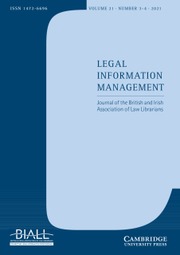No CrossRef data available.
Article contents
Prepare for the AI-Driven Revolution in How We Work with Information
Published online by Cambridge University Press: 29 August 2025
Abstract
There is no doubt that we are now in the midst of an AI-driven revolution in how organisations and their employees work with information. The power of recent GenAI and other deep learning technologies to absorb and process massive amounts of data as well as generate new information in response to natural language prompts has obvious implications for knowledge work. The current developments in more autonomous agentic AI systems alongside the commodification of large language models (LLMs) and reduced barriers to entry for application developers will drive a second wave of innovation over the coming five years. This will cause disruption for many organisations and the workers within them, but such changes seem inevitable. Preparing now to work with these technologies and the opportunities they present as well as mitigate the problems they bring is essential. The opportunities for many information professionals are significant as effectively managing data assets holds the key to competitive advantage in this rapidly changing environment. Here Dr Martin De Saulles, a technology analyst and writer (see page 123 for a review on his new book The AI and Data Revolution: Understanding the New Data Landscape), goes through some of the key points relating to the evolution of AI in relation to those who work with information.
Information
- Type
- Main Features
- Information
- Copyright
- © The Author(s), 2025. Published by British and Irish Association of Law Librarians
References
Endnotes
1 Maxwell Zeff, ‘Klarna’s CEO Says It Stopped Hiring Thanks to AI but Still Advertises Many Open Positions’ (TechCrunch, 14 December 2024) <https://techcrunch.com/2024/12/14/klarnas-ceo-says-it-stopped-hiring-thanks-to-ai-but-still-advertises-many-open-positions/> accessed 22 April 2025.
2 World Economic Forum, ‘The Future of Jobs Report 2025’ (World Economic Forum, January 2025) <www.weforum.org/publications/the-future-of-jobs-report-2025/> accessed 22 April 2025.
3 Thomson Reuters, ‘Future of Professionals Report: AI-Powered Technology and the Forces Shaping Professional Work’ (2024) <www.thomsonreuters.com/content/dam/ewp-m/documents/thomsonreuters/en/pdf/reports/future-of-professionals-report-2024.pdf> accessed 24 April 2025.
4 Warren S McCulloch and Walter Pitts, ‘A Logical Calculus of the Ideas Immanent in Nervous Activity’ (1943) 5 The Bulletin of Mathematical Biophysics 115.
5 AM Turing, ‘Computing Machinery and Intelligence’ (1950) 59 Mind 433.
6 Reuters, ‘OpenAI’s Weekly Active Users Surpass 400 Million’ Reuters (20 February 2025) <www.reuters.com/technology/artificial-intelligence/openais-weekly-active-users-surpass-400-million-2025-02-20/> accessed 24 April 2025.
7 Eduardo Baptista, ‘What Is DeepSeek and Why Is It Disrupting the AI Sector?’ Reuters (28 January 2025) <www.reuters.com/technology/artificial-intelligence/what-is-deepseek-why-is-it-disrupting-ai-sector-2025-01-27/> accessed 24 April 2025.
8 Carlota Perez, Technological Revolutions and Financial Capital: The Dynamics of Bubbles and Golden Ages (Edward Elgar 2003).
9 Carlota Perez, ‘Technological Revolutions and Techno-Economic Paradigms’ (2010) 34 Cambridge Journal of Economics 185.
10 Gartner, ‘Gartner Predicts Agentic AI Will Autonomously Resolve 80% of Common Customer Service Issues Without Human Intervention by 2029’ (Gartner Newsroom, 5 March 2025) <www.gartner.com/en/newsroom/press-releases/2025-03-05-gartner-predicts-agentic-ai-will-autonomously-resolve-80-percent-of-common-customer-service-issues-without-human-intervention-by-20290> accessed 25 April 2025.
11 Deloitte, ‘Autonomous Generative AI Agents: Under Development’ (Deloitte Insights, 19 November 2024) <www2.deloitte.com/us/en/insights/industry/technology/technology-media-and-telecom-predictions/2025/autonomous-generative-ai-agents-still-under-development.html> accessed 25 April 2025.
12 US Bureau of Labor Statistics, ‘US Labour Statistics’ (Bureau of Labor Statistics, April 2025) <www.bls.gov/opub/mlr/2025/> accessed 25 April 2025.
13 Carsten Jung and Bhargav Srinivasa Desikan, ‘Transformed by AI’ (Institute for Public Policy Research 2024).
14 Ernest Hemingway, The Sun Also Rises (first published 1926, Simon & Schuster 2006).

